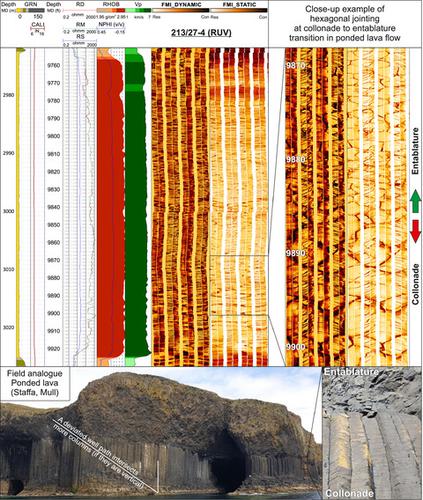当前位置:
X-MOL 学术
›
Basin Res.
›
论文详情
Our official English website, www.x-mol.net, welcomes your
feedback! (Note: you will need to create a separate account there.)
The Rosebank Field, NE Atlantic: Volcanic characterisation of an inter-lava hydrocarbon discovery
Basin Research ( IF 2.8 ) Pub Date : 2021-07-16 , DOI: 10.1111/bre.12585 John M. Millett 1, 2 , Dougal A. Jerram 3, 4 , Ben Manton 1 , Sverre Planke 1, 4, 5 , Peter Ablard 6 , Dirk Wallis 6 , Malcolm J. Hole 2 , Harry Brandsen 6 , David W. Jolley 2 , Cliona Dennehy 6
Basin Research ( IF 2.8 ) Pub Date : 2021-07-16 , DOI: 10.1111/bre.12585 John M. Millett 1, 2 , Dougal A. Jerram 3, 4 , Ben Manton 1 , Sverre Planke 1, 4, 5 , Peter Ablard 6 , Dirk Wallis 6 , Malcolm J. Hole 2 , Harry Brandsen 6 , David W. Jolley 2 , Cliona Dennehy 6
Affiliation

|
The Rosebank Field is located in the Faroe-Shetland Basin and hosts hydrocarbons within siliciclastic sediments interlayered with volcanic packages of the Late Paleocene to Early Eocene aged Flett Formation. Within this study the volcanic sequences are investigated based on an integrated appraisal of available drill cuttings, sidewall cores, core and wireline logs including image log and geochemical logs from eight wells supported by 3D seismic data. The Rosebank lower (RLV), middle (RMV) and upper (RUV) volcanic sequences are inter-layered with Colsay Member (C1–C4) fluvial to shallow marine siliciclastic intervals. A comprehensive cross-field borehole based lithofacies interpretation is presented characterising simple, compound and ponded effusive lava flow facies along with pillow lavas, invasive lava flows, volcaniclastic sediments and complex lava–sediment interactions. Geochemical analyses of core, sidewall core, and hand-picked cuttings spanning the field reveal separate high-titanium (RHT) and relatively lower-titanium (RLT) basaltic magma suites. These compositions can be identified and correlated across much of the field utilising geochemical logging data which, in combination with the geochemical analyses, reveals a two-part stratigraphic sub-division of each of the RLV, RMV and RUV. Geochemical logging data is also used to define a volcanic proxy (Fe/10+Ti) which utilises the elevated iron (Fe) and titanium (Ti) within all effusive and volcaniclastic basaltic lithologies to differentiate siliciclastic from volcaniclastic sediments where other logging parameters overlap. By comparing the borehole analyses with seismic data, a localised eruptive vent is interpreted within the north of the field. Finally, a cross-field volcanic model is presented and compared with relevant global field analogues, providing a constrained spatial framework for sub-surface modelling of inter-volcanic sequences.
中文翻译:

大西洋东北部罗斯班克油田:熔岩间油气发现的火山特征
Rosebank 油田位于 Faroe-Shetland 盆地,在硅质碎屑沉积物中含有碳氢化合物,与晚古新世至早始新世年代的 Flett 地层火山包夹层。在这项研究中,基于对可用钻屑、侧壁岩心、岩心和电缆测井的综合评估,包括来自 3D 地震数据支持的八口井的图像测井和地球化学测井,对火山序列进行了调查。Rosebank 下部 (RLV)、中部 (RMV) 和上部 (RUV) 火山序列与 Colsay 段 (C1-C4) 河流至浅海相硅质碎屑层段夹层。提出了基于跨场钻孔的综合岩相解释,表征了简单、复合和积水的喷发熔岩流相以及枕状熔岩、侵入熔岩流、火山碎屑沉积物和复杂的熔岩-沉积物相互作用。对整个油田的岩心、侧壁岩心和手工采摘的岩屑进行的地球化学分析揭示了不同的高钛 (RHT) 和相对低钛 (RLT) 的玄武岩岩浆套件。可以利用地球化学测井数据在大部分油田中识别和关联这些成分,这些数据与地球化学分析相结合,揭示了每个 RLV、RMV 和 RUV 的两部分地层细分。地球化学测井数据还用于定义火山代理 (Fe/10+Ti),它利用所有喷流和火山碎屑玄武岩岩性中升高的铁 (Fe) 和钛 (Ti) 来区分硅质碎屑和其他测井参数重叠的火山碎屑沉积物。通过将钻孔分析与地震数据进行比较,一个局部喷发口被解释为油田北部。最后,提出了一个跨场火山模型,并与相关的全球场类似物进行了比较,为火山间序列的地下建模提供了一个受约束的空间框架。
更新日期:2021-07-16
中文翻译:

大西洋东北部罗斯班克油田:熔岩间油气发现的火山特征
Rosebank 油田位于 Faroe-Shetland 盆地,在硅质碎屑沉积物中含有碳氢化合物,与晚古新世至早始新世年代的 Flett 地层火山包夹层。在这项研究中,基于对可用钻屑、侧壁岩心、岩心和电缆测井的综合评估,包括来自 3D 地震数据支持的八口井的图像测井和地球化学测井,对火山序列进行了调查。Rosebank 下部 (RLV)、中部 (RMV) 和上部 (RUV) 火山序列与 Colsay 段 (C1-C4) 河流至浅海相硅质碎屑层段夹层。提出了基于跨场钻孔的综合岩相解释,表征了简单、复合和积水的喷发熔岩流相以及枕状熔岩、侵入熔岩流、火山碎屑沉积物和复杂的熔岩-沉积物相互作用。对整个油田的岩心、侧壁岩心和手工采摘的岩屑进行的地球化学分析揭示了不同的高钛 (RHT) 和相对低钛 (RLT) 的玄武岩岩浆套件。可以利用地球化学测井数据在大部分油田中识别和关联这些成分,这些数据与地球化学分析相结合,揭示了每个 RLV、RMV 和 RUV 的两部分地层细分。地球化学测井数据还用于定义火山代理 (Fe/10+Ti),它利用所有喷流和火山碎屑玄武岩岩性中升高的铁 (Fe) 和钛 (Ti) 来区分硅质碎屑和其他测井参数重叠的火山碎屑沉积物。通过将钻孔分析与地震数据进行比较,一个局部喷发口被解释为油田北部。最后,提出了一个跨场火山模型,并与相关的全球场类似物进行了比较,为火山间序列的地下建模提供了一个受约束的空间框架。











































 京公网安备 11010802027423号
京公网安备 11010802027423号